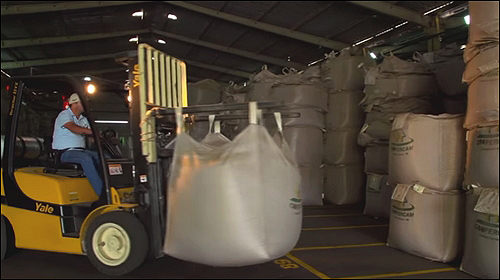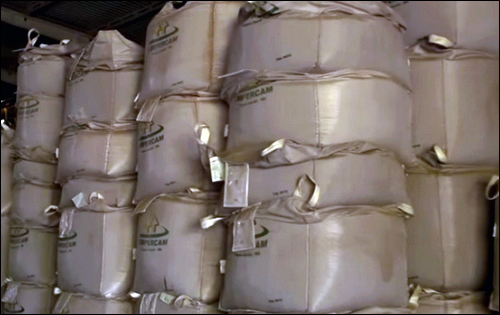Jan 08, 2016The Cooperativa dos Cafeicultores de Campos Gerais e Campo do Meio Ltda (Coopercam)—the Cooperative of Coffee Growers of Campos Gerais and Campo do Meio—is employing radio frequency identification technology to automatically manage its inventory of coffee beans. The cooperative, which is composed coffee growers, as well as producers of milk and other agricultural and livestock products, is located in Campos Gerais (near the southern tip of the Brazilian state of Minas Gerais), a city with a high number of small farms and an annual production of 600,000 bags of coffee beans.
According to Hendrix Brasiliense, a partner with BrasilSync, the company that served as the RFID deployment's systems integrator, the technology has enabled Coopercam to increase the agility of its processes, reduce the amount of time it takes employees to perform tasks related to coffee storage, cut costs and easily access information regarding the types of coffee beans available.

"Managers follow everything that happens inside the warehouse," Brasiliense says. "Thus, RFID proved to be a viable solution, which improved processes and brought more reliability in performing the tasks."
Forklifts are equipped with RFID readers for identifying each coffee bag and ensuring that it is placed in the correct location. Once the coffee arrives at the warehouse, information about the beans and their storage location is linked to each bag's tag ID number and recorded in the system. "This information is forwarded by Wi-Fi in real time," Brasiliense says, indicating that all of the data is easily accessible via a Web-based platform.
RFID tags are used to map the storage location of each bag of coffee beans. "The tags used for location management generate information on the map of the warehouse," Brasiliense explains. "Each bag has a pouch where we put the tag that will identify the item. Then, when coffee is unloaded and sent to the bag, the whole process has become automatic."
Embedded in the warehouse floor are passive ultrahigh-frequency (UHF) RFID tags that the forklifts' readers interrogate. If a bag is placed in the wrong location, a screen on the vehicle's dashboard warns the driver, who must then move the product to the correct storage area.
The RFID system provides a map of the warehouse that depicts each bag's location in real time. Filter options enable users to search for a certain type of coffee. "Another issue that has been facilitated is related to coffees that are certified," Brasiliense states. "It is now possible to visually locate them through the positioning system inside the warehouse, streamlining an audit."
The middleware used for this project was developed by BrasilSync, which is based in the city of Paraguaçu, also in Minas Gerais. "The middleware filters the raw data collected by the forklift reader's antenna, adds business intelligence and updates the system server," Brasiliense says.
Coopercam's decision to invest in an RFID system began with a challenge: find a solution to manage the warehouse routines involving the receipt and storage of coffee beans. "Another important aspect," Brasiliense notes, "was seeking a way to provide the most accurate information about the movement of bags inside the warehouse or when the coffee comes out of a particular storage place and goes to another."
After searching for options available on the market, but failing to find any able to manage all of these processes, Coopercam determined that RFID technology might be the basis of a viable solution. "With the implementation of the RFID system," Brasiliense says, "we could automate the entire process of tracking the bags' storage and movement."
The applied technology made the warehouse processes much simpler and more agile, Brasiliense says, in view of Coopercam. "RFID today helps us locate more than 4,500 bags of coffee in more than 1,200 storage locations available within the warehouse—which, with pen and paper, would be a job virtually impossible or highly prone to errors," he attests.
An RFID reader is installed in each forklift truck and connected to an onboard computer with a touchscreen. The computer communicates with the data server and displays the process information for the machine's operator. The reading is performed continuously, in accordance with a preset configuration.
The deployment employs two models of readers: the M6e, from ThingMagic and the Edge-50, from Acura Global. "We have four readers currently in use and are preparing to install 20 more," Brasiliense says, adding that Coopercam is using RFID tags made by Smartrac. "Today we have 16,000 tags in use, but with new deployments, that number could reach approximately 65,000."
The implementation of RFID originated with a suggestion from Coopercam's IT department after an analysis of the business process was carried out. "The cooperative's board gave full freedom for the team to seek a viable solution to solve the problem," Brasiliense recalls, "since it shared the same view of the problem."
In the warehouse at present, according to Brasiliense, "three people manage the entire process—both the loading and unloading of coffee." Using RFID, he says, the three workers can process a shipment of 500 bags in less than 30 minutes.
"The RFID system shows location and type of coffee to be shipped, relating to beverage classification, appearance, color, among other characteristics," Brasiliense explains. "Another advantage is, when a bag is taken from its current storage location and moved to another, that change is automatically updated by means of the RFID tags."
The next steps, Brasiliense reports, include a plan to use RFID to track the locations of the samples in the classification room, so that each batch of coffee received is identified and linked to information relating to that particular lot. The idea is to utilize RFID tags to manage these samples, which are stored on shelves within the classification room, so that whenever coffee needs to be shipped, its sample could be easily located and used for tasting purposes. "We will be able to create a historical record proof of that lot," Brasiliense states, "and know if, over time, it suffered some variation."



